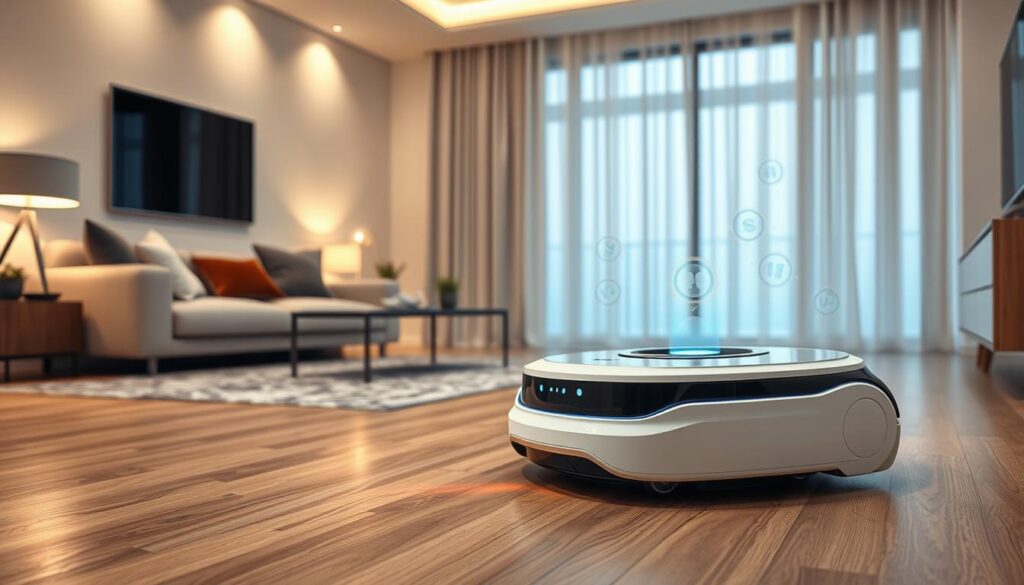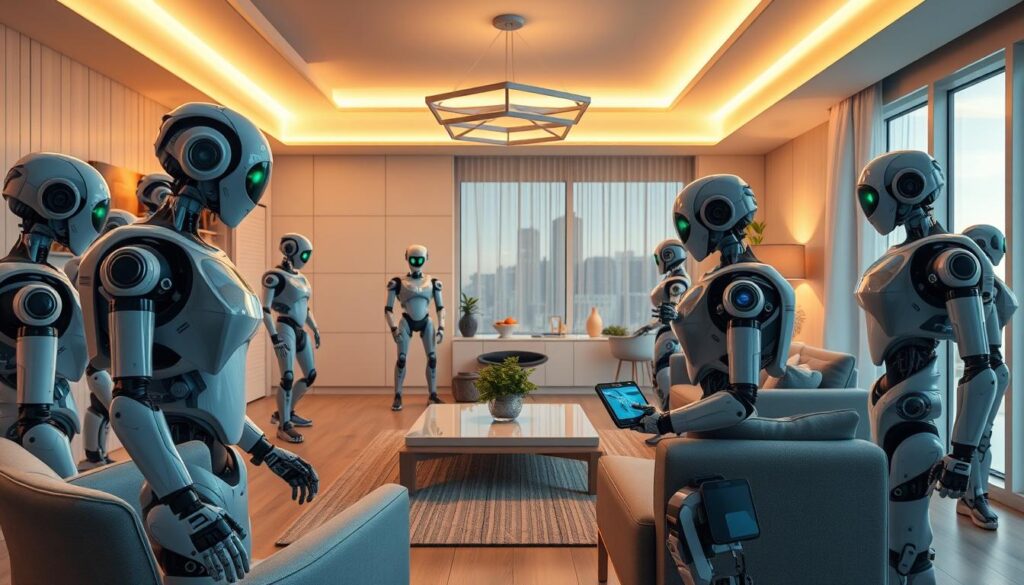The Internet of Things (IoT) and robotics together are changing home automation. IoT robots make our homes more efficient and easier to manage. They let us monitor our homes from afar and predict when things might need fixing.
These robots use sensors and advanced tech to make our homes better. They help us save time and make our homes run smoother.
IoT robots can check on equipment health from anywhere, boosting efficiency by 30%. They also make us 40% more productive by analyzing data in real-time. Plus, they cut maintenance costs by 60% by predicting when things will need fixing.
But, there are hurdles to overcome. 70% of businesses struggle to connect IoT devices with robots smoothly. 80% worry about keeping their systems safe from hackers.
It’s important to solve these problems. That way, we can fully enjoy the benefits of IoT robots in our homes.
The Intersection of IoT and Home Robotics
The Internet of Things (IoT) has changed how we use home robots. IoT sensors and connectivity give robots better perception and smarts. This makes tasks like cleaning and security easier for us.
IoT-Enabled Sensors and Connectivity in Robotic Systems
IoT sensors help home robots gather and use data quickly. They’re used in home automation, smart home management, and connected device integration. This lets robots adjust to our needs and the environment.
Advanced Perception, Intelligence, and Autonomy for Robots
IoT and artificial intelligence, machine learning, and computer vision make robots smarter. They can see, decide, and act on their own. This change could make our lives easier and more efficient at home.
| Sector | IoT-Enabled Robotics Applications | Key Benefits |
|---|---|---|
| Manufacturing | Smart factories, predictive maintenance, collaborative robots (cobots) | Increased automation, reduced maintenance costs, improved productivity |
| Healthcare | Remote surgeries, patient monitoring, IoT-integrated prosthetics | Enhanced patient care, increased satisfaction, improved outcomes |
| Agriculture | Precision farming, livestock monitoring | Increased crop yields, reduced animal loss, improved resource management |
| Smart Homes | Home automation, energy management | Increased efficiency, reduced energy consumption, enhanced convenience |
| Transportation and Logistics | Autonomous vehicles, warehouse automation | Improved safety, reduced processing time, increased efficiency |
Applications of IoT in Home Robotics
The Internet of Things (IoT) has changed how we live in our homes. It has also made a big impact on home robotics. IoT-powered home robots are used for many things, like cleaning and keeping our homes safe.
Automated Cleaning and Household Tasks
IoT home robots are now used for cleaning and doing chores. They use sensors and data to vacuum, mop, and even clean windows. They work well with smart homes, so they can clean when you want them to.
This means your home stays clean without you having to do much. It’s a big help for keeping your home tidy.
Home Security and Monitoring Systems
IoT and home robotics have also improved home security. Smart locks, cameras, and alarms can now work with robots. This makes your home safer and lets you control it from anywhere.
You can watch your home, control security, and get alerts on your devices. It’s a great way to feel safe and in control of your home.
IoT and home robotics are changing how we do things at home. They make our lives easier and more convenient. As more people use smart home tech, we’ll see even more ways IoT robots can help us.

Challenges of Integrating IoT and Robotics
As IoT and home robotics merge, businesses and consumers face big challenges. Making sure IoT devices and robots work together smoothly is hard. Without proper planning, these systems often don’t work well together.
The IoT’s connected nature also raises cybersecurity and data privacy concerns. Keeping data safe from hackers is a big challenge. Cyber threats can target IoT networks, putting home security at risk.
Overcoming these technical obstacles is key for IoT-powered home robotics to reach its full potential. Companies and developers need to focus on interoperability, compatibility, cybersecurity, and data privacy. By tackling these issues, they can make IoT-integrated home robotics systems work well for everyone.
Home robot development
The field of home robots using Internet of Things (IoT) tech is growing fast. Engineers and researchers are working hard to add advanced sensors, connectivity, and smart algorithms. They aim to make robots that can easily work in our homes. This includes using artificial intelligence, machine learning, and computer vision to improve how robots see, decide, and act on their own.
New advancements in robotics engineering and autonomous systems have sparked interest in home robots. Companies like Tesla, Amazon, and Dyson are investing a lot in this area. They want to make home robots that can do many tasks. But, using these robots in homes is still new compared to smart devices like thermostats and security systems.
Household robots struggle with handling delicate, soft, or odd-shaped items. They lack good force feedback, especially in making robot hands with flexible fingers. Also, making robots that can move and manipulate objects at the same time is a big challenge.
As tech gets better, we’ll see more advanced home robots. They will be able to do more tasks and fit the needs of homeowners. While we might see robots for specific tasks like cleaning or cooking soon, making a robot for everything is a big challenge. Researchers and engineers are working hard to solve this problem.

Benefits of IoT-Powered Home Robotics
IoT technology in home robotics brings many benefits. It changes how we do daily tasks, making life easier and more efficient. These robots work better and use less energy. They also let homeowners control and care for them from anywhere, cutting down on the need for hands-on work.
Enhanced Efficiency and Convenience
IoT home robots use sensors and advanced automation to make household chores easier. They can move around, clean, and take care of the home on their own. This means more free time for you, thanks to smart home devices that work with these robots through apps and voice commands.
Remote Monitoring and Maintenance Capabilities
IoT home robots let you watch over and manage them from anywhere. You can see how they’re doing and what they’re up to in real-time. This makes it easy to fix issues and keep them running smoothly without having to be there.
IoT and home robotics together are changing how we live. They offer more automation, customization, and control in our homes. With these benefits, IoT home robotics is making our lives easier and more efficient.
IoT Data Analytics for Robotic Optimization
The Internet of Things (IoT) and home robotics have opened up new ways to improve robotic systems at home. IoT data analytics helps homeowners and service providers understand how their robots work. They can see how well they perform, when they need maintenance, and how to make them better.
IoT sensors are key to this improvement. They gather data on how well the robots work, their patterns, and the environment. This data is analyzed to help make better choices and improve robot efficiency.
IoT data analytics also helps with predictive maintenance. It spots problems early, so robots don’t break down. This means less downtime and better performance. Robots can also adjust to changes in their environment, making them more efficient and saving energy.
Moreover, IoT data analytics helps make better decisions about robots. Homeowners can see how their robots are used, how much energy they use, and how well they perform. This information helps decide when to upgrade or replace robots.
In summary, IoT data analytics is crucial for improving home robotics. It uses sensor data to make robots more efficient, predictive, and responsive. This changes how we use and manage our robotic helpers at home.
| Key IoT Sensors in Robotic Systems | Applications |
|---|---|
| Temperature Sensors | Monitoring motor and component temperatures for predictive maintenance |
| Pressure Sensors | Detecting changes in pneumatic or hydraulic systems for fault detection |
| Proximity Sensors | Enabling collision avoidance and path planning for autonomous navigation |
| Motion Sensors | Tracking robot movements and identifying operational patterns for optimization |
| Force/Torque Sensors | Monitoring joint forces and torque loads for predictive maintenance and control |
Conclusion
The Internet of Things (IoT) and home robotics are changing how we live. They bring new levels of automation, efficiency, and convenience to our homes. With advanced sensors, connectivity, and smart algorithms, IoT robots can do many tasks better.
This technology is growing fast, opening up endless possibilities for our homes. It’s making our living spaces smarter, more efficient, and tailored to our needs. Homeowners can expect a future where technology and home life blend seamlessly.
Cost-effective robots and better human-robot interaction are on the horizon. Robots will help with tasks like package delivery and keeping our homes safe. The mix of IoT and robotics is leading to a smarter, more automated home life.

